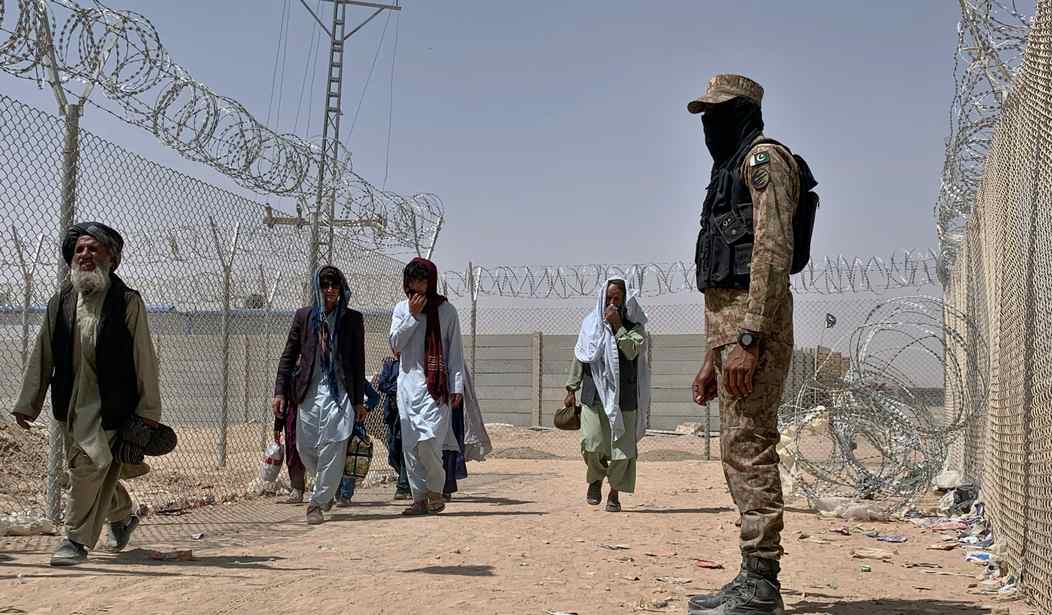“It’s a giant can of worms,” said a U.S. Citizenship and Immigration Services official who asked not to be named, and in these days of rapidly increasing Biden administration authoritarianism, it’s easy to see why. Grateful Afghan refugees are, according to Reuters, upsetting the establishment narrative in large numbers by engaging in “independent departures” from the U.S. military bases where the evacuees are being housed. That is, they’re getting up and walking away, and no one knows where they are. At least 700 Afghans have now left various military bases and are somewhere in the United States. Over 300 have vanished from Fort Bliss alone. No one knows where. What could possibly go wrong?
Remember: Biden’s handlers have no idea who most of these people are. Back on September 1, according to Politico, “a State Department official said in a private briefing to reporters that ‘the majority’ of special immigrant visa applicants were left in Afghanistan due in part to the complications of the evacuation, and that he and his team are ‘haunted’ by the evacuees the U.S. could not get out by the Aug. 31 deadline.” That is, the vast majority: Homeland Security Secretary Alejandro Mayorkas admitted on September 21, according to The Hill, that “of the 60,000 Afghans who have entered the U.S., nearly 8,000 are either U.S. citizens or residents, while about 1,800 are SIV holders, having obtained visas after assisting the U.S. military.”
That leaves around 50,200 Afghan refugees for whom we have no certain identification and no assurance whatsoever that they aren’t jihad terrorists. Nor is that all: The Hill states without a trace of irony that Biden’s handlers have “boasted” about having brought “more than 124,000 people from Afghanistan.” Who is among the other 74,000 who are apparently on their way here? No one knows.
Daniel Greenfield notes that there are three possibilities as to why these evacuees have disappeared from the military bases and left no forwarding address: “They’re not legally who they say they are and are worried that the authorities will find out”; or “they’re committing a crime such as trafficking young girls as had already been reported at Fort McCoy”; or “they’re terrorists here to infiltrate America.”
That third possibility becomes more likely in light of the unpleasant fact that Business Insider reported on August 15:
Thousands of inmates, including former Islamic State and al-Qaeda fighters, were released from a prison on the outskirts of Kabul as the Taliban called for a “peaceful transition” of power. Afghan government troops surrendered Bagram airbase to the Taliban early on Sunday. The base houses Pul-e-Charki prison, which has around 5,000 prisoners. It is the largest in Afghanistan and notorious for its poor conditions. A maximum-security cellblock held members of al Qaeda and Taliban, said reports. Footage published by an independent Afghan news agency, which supports the Taliban, appears to show militants letting the inmates out.
Did any of these al-Qaeda and Islamic State jihadis get on planes bound for America? No one knows.
The Department of Homeland Security (DHS), of course, wants you to relax. A DHS spokesperson said that the Afghans who disappeared “generally” had family and friends in the United States, as well as enough money to be able to fend for themselves.
“Generally”! And what of the others? The DHS wonk didn’t say.
Related: As Trump Warns of Terrorism From Afghan Refugees, Some in GOP Look for Ways to Welcome Them
However, refugee resettlement officials also emphasized that every last one of the disappeared Afghans had “already undergone security screening before arriving in the United States.” Oh, well, then! Biden administration officials have already demonstrated their serene competence in so very many areas, we have no reason not to trust them in this one, right? Never mind the fact that Old Joe insists that Islam is a religion of peace and that his handlers don’t even admit that there is a global Islamic jihad – they can still vet for it with one hundred percent accuracy, right?
Meanwhile, Reuters was only worried that the Afghans who fled would miss out on the largesse coming to them: “But leaving early could cost other Afghan evacuees critical benefits – like expedited work permits – and create a slew of legal problems down the road, given the complexities of the U.S. immigration system.” The anonymous U.S. Citizenship and Immigration Services official added: “This could lead to years and years of terrible immigration status problems.” Yeah. The consequences could be explosive.
Afghan refugees are apparently handed a paper called “Departee Information,” which is, according to Reuters, “meant to warn Afghans considering leaving before completing their resettlement. It reminds them that, on base, they can get their immigration paperwork processed and even cash to help pay for travel to their destination in the United States. ‘Once you leave this base, you forfeit these advantages and may not return,’ it reads.”
Reuters was worried that this might appear too harsh, and so brought in “Margaret Stock, an immigration lawyer with expertise in cases related to the military, said the warning was not ill-intentioned. ‘I think they’re trying to look out for people,’ she said. ‘The people managing the bases are rightfully concerned that somebody might not be fully aware of the consequences of wandering off.’”
Gee, that’s great, but is anyone in this entire insane regime fully aware of the possible consequences for Americans of the Afghans wandering off?
Meanwhile, more are likely to walk away: “Immigration experts say Afghans who leave the bases are not breaking U.S. laws and military officials have no legal authority to hold law-abiding Afghans against their will at any of the eight locations hosting 53,000 Afghans who fled the Taliban on U.S. evacuation flights.”
But go back to sleep: General Glen VanHerck, head of Northern Command, “pushed back on the idea that criminality was a problem on the U.S. bases. He told Pentagon reporters on Thursday that the numbers of incidents involving robbery and theft were substantially lower than in the general U.S. population, with only eight cases in six weeks.”
What about other crimes, such as, for example, assault? For some reason, VanHerck didn’t say anything about those. Why not?










Join the conversation as a VIP Member